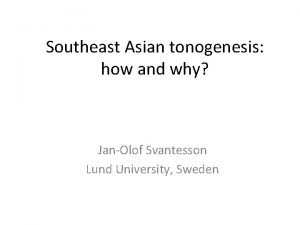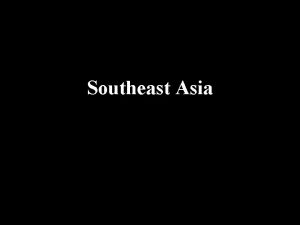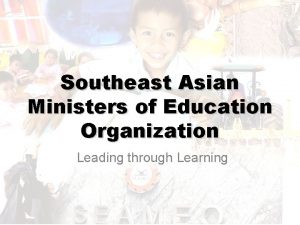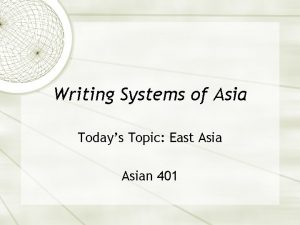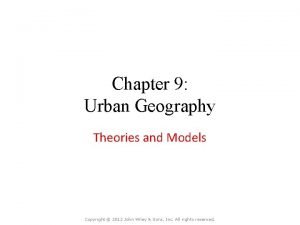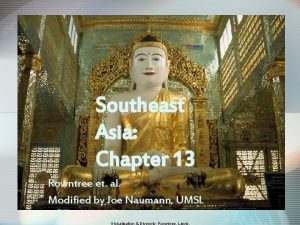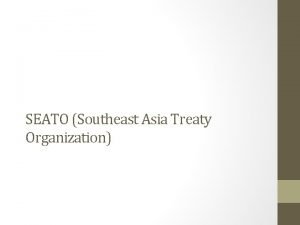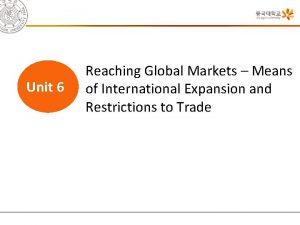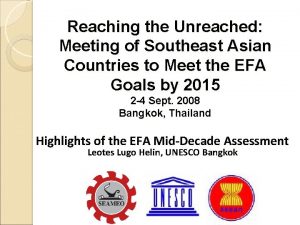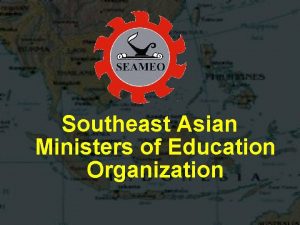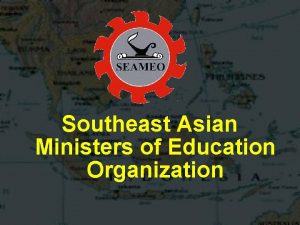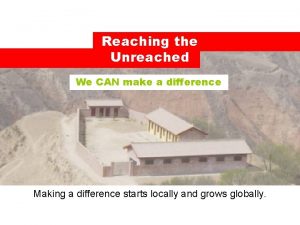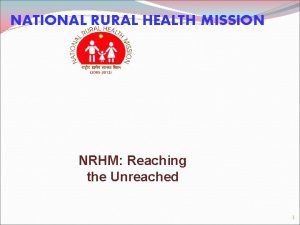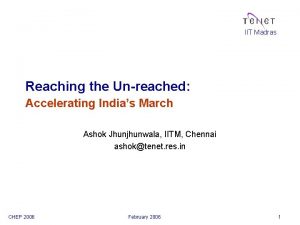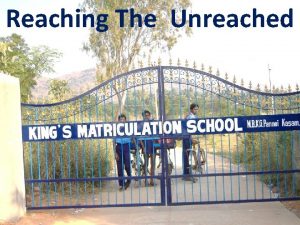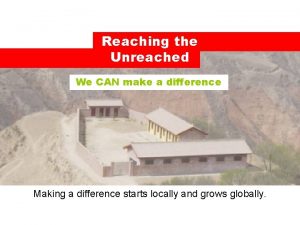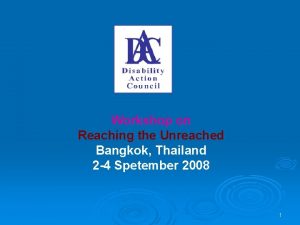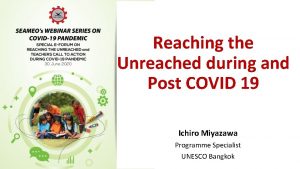Reaching the Unreached Meeting of Southeast Asian Countries






















- Slides: 22

Reaching the Unreached: Meeting of Southeast Asian Countries to Meet the EFA Goals by 2015 2 -4 Sept. 2008 Bangkok, Thailand

Why focus on the unreached and the under-served target groups for EFA? UIS-AIMS Unit, UNESCO Bangkok UNESCO INSTITUTE for STATISTICS Pprepared by Ko-Chih Tung

EFA Mid-Decade Assessment Objectives • Build national capacity to undertake M&E, MDA & Mid • • Term Policy Reviews Assess progress and gaps in the achievement of the national and global targets of EFA Identify and locate the remaining gaps in terms of quality and equity sub-nationally, with a focus on the disadvantaged and excluded populations Review, identify and locate problems, issues, policies, strategies, actions and critical factors of success/failure Use results of the assessment to sharpen the focus and update policies and strategies for attaining the EFA goals and the MDGs by 2015

EFA Mid-Decade Assessment Framework for the Assessment: Inclusive Education in a Lifelong Perspective • a focus on the diversity of learning needs of sub-populations (e. g. , • the disabled, linguistic and ethnic minorities, girls and women, disadvantaged groups) provision of quality education for all learners The MDA aims to answer: • Which children are not in school/learning centres? • What inhibits their full participation? • Who should be targeted as a priority? • How can we improve quality and equality? • How do we cost, budget and finance EFA?

Who are the “unreached”? the lowest range on indicators of education participation (e. g. , enrolment rate) and performance (e. g. , completion rate, level of education) l may be in school, but their learning achievement scores are significantly lower than the average for the nation, e. g. the bottom quartile l greatest distance to reach the EFA Goals and Targets l

Who are the “under-served”? The “underserved” groups are those who l Lack educational opportunities and access to educational services, materials and facilities. l Lack access to the distributed educational resources, as compared to the national average, e. g. . , budgetary allocation, number of schools, qualified teachers, textbooks, etc. relative to the school-age population l For reasons of geographical, financial, political, linguistic, legal, socio-cultural, etc.

Who are the unreached and underserved? How shall we effectively include them in EFA? l l l l l Learners from remote and rural communities, including isolated Learners from linguistic and ethnic minorities/indigenous peoples, minority religious groups, etc. Girls and women, especially from rural, ethnic minorities (pregnant girls) Underperforming boys, boys at risk of dropping out, male dropouts Children from migrant families, refugees, stateless children Learners with disabilities/special needs Children in difficult circumstances (affected by armed conflict, disaster, children in prison or who are with their parent(s) in prison) Learners from very poor families (urban poor, poor families in remote areas) Child labourers/ street children/ trafficked children/abused children Children affected or infected by HIV and AIDS Orphans and abandoned children

What inhibits their full participation? E. g. Low enrolment rate among children of migrant workers Conditioning factors: policy affected l l l Legal requirement Compulsory/noncompuls ory primary education Budgetary allocation for migrant workers/ noncitizens Availability of schools, teachers and places Absence of clear authoritative directive language of instruction Laws on citizenship, registration, work permit, resident permit Immediate factors Individual attributes l l l l Birth certification Citizenship Residence permit Work permit (parents) Legal ID card Poverty – household income Fear of deportation Language barrier

MDA: Where do we stand now? National EFA MDA reports finalised: l Indonesia and Myanmar National EFA MDA reports being finalised: Cambodia, Lao PDR, Malaysia, Philippines, Thailand Viet Nam Sub-Regional EFA MDA reports now being printed Insular Southeast Asia: Indonesia, Malaysia and Philippines Mekong: Cambodia, Lao PDR, Myanmar, Thailand Viet Nam

EFA MDA and Policy Review • Results of national and sub-regional EFA MDA and the 2008 • Global Monitoring Report used for policy reviews Recommendations for adjustments in terms of: ØTarget-setting, with specific references to priority target groups ØStrategies for attaining the unattained and reaching the un- reached ØA schedule of milestones to be attained over the remaining period • Sub-Regional EFA Mid-Term Policy Reviews to be conducted in Asia-Pacific (the first held in Southeast Asia in February)

Policy and Strategy Recommendations: South-East Asia EFA Policy Review • Identified specific target groups; in particular, unreached and disadvantaged populations • Defined “Inclusive Education” and “Quality” of education • Identified critical issues / major challenges using a lifelong learning approach • Recommended policies and strategies on how to address these issues • Identified good practices and innovative ideas

Going to scale: develop capacity for implementation and sustainability source: FTI CD Guidelines

Challenges in getting information on unreached groups in Southeast Asia UIS-AIMS Unit, UNESCO Bangkok UNESCO INSTITUTE for STATISTICS Pprepared by Nyi THAUNG

Availability of data on unreached groups • • Reaching the unreached: the major theme for EFAMDA Findings from the EFA MDA • Most country reports tried to present the situation of unreached groups in relation to the provision and quality of education and other relevant aspects. Reports have sections on: • Identifying the unreached groups • Relevant policies and interventions • Implementation of programmes, activities • Difficulties and challenges in implementing the programmes • Results and achievements

Data Collection and Reporting l l l l Not all countries disaggregate the data into rural/remote Focus is on gender disaggregation Best-practice: Lao divided regions into poorest, poor, nonpoor and provides data on ethnic groups Time series provide the means of observing narrowing or widening of gaps (applied in some countries as Cambodia, Viet Nam, Philippines and others) Efforts are made in collecting data on pupils with disabilities Data on Children in difficult circumstances, child labourers/ street children/ trafficked children/abused children, children affected or infected by HIV and AIDS, orphans and abandoned children is rare Myanmar and the Philippines provide some information on these groups

Examples of data mentioned in MDA reports l l l Indonesia has very low participation of children with disabilities in ECCE (2% GER in 2005) The number of working children has declined from 670, 000 in 2004 to 516, 000 in 2005 (Indonesia) Significant differences in transition rate from primary to secondary exist across the provinces, varying from 77% in Sulawesi Utara to 43% in Kalimantan Tengah. (Indonesia) Participation of children from indigenous groups in ECCE almost tripled from 2000 to 2005, from 10, 726 to 29, 723 (Malaysia) 71. 2% of children from rural areas and disadvantaged students exhibit lower literacy skills (Malaysia) NER in rural areas improved from 78% in 2002 to 87. 1% in 2005 while that for urban areas decreased from 85. 7% to 77. 6% during the same period (Philippines)

Examples from the MDA reports • • In the past half-decade, the number of students from the main ethnic group declined by 8%, while the number of students from other ethnic groups rose considerably (Lao PDR) In 2002/03, 12. 9% of children enrolled in ECCE were ethnic minorities; by 2005/06, the figure rose to 13. 8%, :

Examples of data use in the MDA reports

Challenges • Limited availability of data: only partial or incomplete • • Data are never collected Data are collected but not as part of the routine channels • Ad-hoc, one-time, case specific Data exists but there is no information on where and how to get the data Quality of data is beyond the acceptable, publishable level

Challenges • Organization of available data • • Information is available • from various institutions (difficulty in compilation) • in various forms, formats, medias (difficulty in transforming into interpretable format) • based on different concepts, definitions and methodologies (difficulty in consolidating and comparing) Capacity • • • Lack of skills, capacity and interest Lack of financial resources Lack of institutional mandate • to collect, compile and analyze the information

Discussion points Getting information for the reaching the unreached group • What to collect • In which detail – disaggregation • How to collect • Who should consolidate, maintain, distribute • How to coordinate • How to build the capacity to do the above

Next Steps • One proposed action for the countries is to consider a Mapping Study on availability of data on reaching the unreached • Who are collecting the data, who are the data users • How are data collected • What are the data-related issues • Where can data be accessed/collected
 City model
City model Southeast asian features
Southeast asian features Southeast asian architecture
Southeast asian architecture Latin america urban model
Latin america urban model Southeast asian alphabets
Southeast asian alphabets Latin american model
Latin american model Southeast asian ministers of education
Southeast asian ministers of education City model
City model Writing systems of asia
Writing systems of asia Southeast asian city model definition ap human geography
Southeast asian city model definition ap human geography Countries in southeast asia
Countries in southeast asia Seato dissolved
Seato dissolved Wallace's line
Wallace's line Countries in southeast asia
Countries in southeast asia Meeting objective
Meeting objective What is meeting and types of meeting
What is meeting and types of meeting For today's meeting
For today's meeting Types of meeting
Types of meeting Reaching global markets
Reaching global markets Chapter 22 reaching out cross-cultural interactions
Chapter 22 reaching out cross-cultural interactions Forgetting those things which are behind nkjv
Forgetting those things which are behind nkjv Chapter 22 reaching out cross-cultural interactions
Chapter 22 reaching out cross-cultural interactions Chapter 22 reaching out cross-cultural interactions
Chapter 22 reaching out cross-cultural interactions

